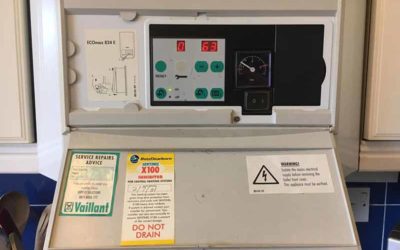What is a Consumer Unit?
A Consumer Unit may be aclled many things; a Distribution Board ot a Fuse Box. Just for consistency (and ease), we will call it a Consumer Unit, or CU for short.
Whatever you decide to call it, it is the means by which electricity is distributed throughout your house.
At its most basic level, it should have a Main Switch, (to allow you to turn off the whole electrical supply to your house), and a number of different size fuses, or MCBs, which control the indiviudal circuits within your house.
Consumer Units come in many different shapes, sizes and levels of safety. We will highlight some of these below.
Types of Consumer Units
CU with Re-wireable Ceramic Fuses
This CU has ceramic rewireable fuses, housed in a wooden box. If a fuse blows (stops working), it needs to be removed and the fuse wire running through it replaced. It is quite a fiddly operation, particularly in the dark, when you can’t find the fuse wire.
This type of CU will protect your circuits against overloading. The fuse wire should break if the demand is too high. It will not protect you against electrocution/serious injury or death, if a fault occurs and you come into contact with an electrical current.
These are very beautiful to look at, but belong in a museum. If you have one of these, we would recommend that you call an electrician in as soon as possible. It needs to be upgraded to something a lot safer.
CU with re-wireable Fuses
These are still pretty common. We see them in many houses. As with the first CU, these only provide you with protection against overloading a circuit.
Both of these CUs allow you to reset the fuses by either pushing a button or moving a lever, rather than re-wiring the fuses, which makes them slightly easier to operate.
If you have one of these, and you want any electrical work carried out in your house, some form of upgrading will have to be carried out before that happens. Current safety regulations will not allow electrical work to be carried out without RCD protection.
These CUs will not protect you against electrocution, if a fault occurs.
CU with Main Switch & RCBOs
This CU has a Main Switch and a mixture of individual fuses (MCBs) and RCBOs.
The circuits protected only by an MCB are protected against overloading. Under current regulations, the lighting circuits, which are only protected by an MCB will need their protection upgraded to an RCBO, if any work is carried out.
The circuits protected by RCBOs, are protected against overloading and electrocution.
CU with RCD as a Main Switch
This CU has an RCD which operates as a main switch.
The benefit of this CU, is that you have RCD protection. This will protect you against being electrocuted if a fault occurs.
The downside is that all your circuits are controlled by that single RCD. If a fault occurs on one of your circuits, then none of your circuits will operate until that fault is repaired. This can be a bit of a nuisance.
CU with RCD as a Main Switch
Until recently most old CUs were upgraded to this kind of Dual RCD CU. Initially they were made of plastic, but in the past few years they have been made of metal, and greater emphasis has been placed on fire-proofing them.
The circuits in the house are divided into two parts, each controlled by an RCD. If a fault occurs on one RCD, then all the circuits covered by that RCD will be switched off, but the other RCD continues to operate, as do the other circuits.
This is a lot more convenient arrangement.
CU with Individual RCBOs
This newer style CU complies with the most recent regulations.
It has a fire-proof metal enclosure.
Each circuit is controlled by an individual RCBO, which gives RCD protection. If one circuit develops a fault, all the other circuits continue to operate.
In addition, the CU has a Surge Protection Device.
This type of CU is more expensive than the previous CUs, but it offers a higher level of protection and conveneince than all the previous CUs
Labelling
As you will see in many of the above pictures, much of the labelling on Consumer Units can be a bit patchy. It is really useful to know which fuse (MCB) covers which circuit. In the event of an emergency, this may be something you need to know in a hurry.
If your Consumer Unit is not well labelled, this something that you can improve yourself, with the use of some clean white labels and an hour of your time.
Go through each MCB in turn. Switch it off, and identify which sockets/switches/lights etc are no longer working. Make a careful note of what these are and keep the recorn with your Consumer Unit.
You can then update the label on the outside of your Consumer Unit.











0 Comments